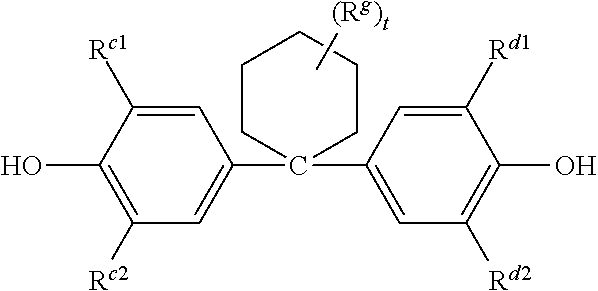Polycarbonate-poly(ether-ester) copolymer composition, method of manufacture, and articles therefrom
a technology of polycarbonate and ether, which is applied in the field of polycarbonatepoly (ether) copolymer composition, method of manufacture, and articles therefrom, can solve the problems of relative lack of transparency of poly(ether) copolymer, lack of room temperature impact ductility of polycarbonate-poly(ether) copolymer composition,
- Summary
- Abstract
- Description
- Claims
- Application Information
AI Technical Summary
Benefits of technology
Problems solved by technology
Method used
Image
Examples
examples
[0090]Table 1 shows the materials that are used in Examples 1-8 and Comparative Examples 1-39.
[0091]
TABLE 1MaterialDescriptionSourceDMBPCBPA polycarbonate comprising 50 mole % of units derived fromSABIC Innovative1,1-bis(4-hydroxy-3-methylphenyl)cyclohexane, Mw = 22,000Plasticsto 35,000BPA-PC-1BPA polycarbonate homopolymer, MFR = 7 at 300° C. / 1.2 kgfSABIC InnovativePlasticsBPA-PC-2BPA polycarbonate homopolymer, MFR = 12 at 250° C. / 1.2 kgfSABIC InnovativePlasticsPC-SiPolycarbonate-siloxane copolymer with a siloxane content of 6 wt %SABIC InnovativePlasticsABSBLENDEX 415 Acrylonitrile Butadiene Styrene terpolymerSABIC InnovativePlasticsPCCD 2kPoly(1,4-cyclohexane dimethanol dimethyl 1,4-cyclohexaneEastman Chemicaldicarboxylate), IV = 0.83PCCD 4kPoly(1,4-cyclohexane dimethanol dimethyl 1,4-cyclohexaneEastman Chemicaldicarboxylate), IV = 0.96NEOSTAR FN006Poly(ether-ester) copolymer based on poly(1,4-cyclohexaneEastman Chemicaldimethanol dimethyl 1,4-cyclohexane dicarboxylate)HYTREL 4056...
examples 4-5
[0117]The purpose of these examples was to determine whether the polycarbonate of formula (1) could be used in conjunction with a polycarbonate homopolymer and still produce ternary blends with both transparency and good impact properties.
[0118]Compositions were made in accordance with the preparation process described above. The compositions were then tested for the indicated properties shown in Table 5 in accordance with the testing procedures described above.
[0119]
TABLE 5FormulationEx-4Ex-5HYTREL 4056wt %52.0HYTREL 4556wt %52.0DMBPCwt %31.731.7BPA-PC-2wt %16.016.0PEPQwt %0.20.2MZPwt %0.10.1Sum (wt %)100100AppearanceVisualtransparenttransparentTransmission%8372Haze%414Vicat, 10N-50° C. / h° C.4665Tensile ModulusMPa11491376Tensile Stress at 5% StrainMPa1725Tensile Stress at 10% StrainMPa1724Tensile Stress at 50% StrainMPa1620Tensile Stress at BreakMPa3941Elongation at Break%244254Nominal Strain at Break%324305Notched Izod, 23° C.% ductility10080J / m15301040Flexural ModulusMPa366663Fle...
examples 9 and 10
[0138]The purpose of this example was to show that the compositions could be made into film and multilayer articles containing the film.
[0139]Multi-layer films were produced with good optical properties, adhesion, and warp resistance. These articles included an A-B-A or A-B assembly, where A is a polymer layer such as a polycarbonate layer, and B is a layer comprising the blends of the polycarbonates of formula (1) with poly(ether-ester) copolymers as described herein. The typical properties of a commercial film layer came from the A layer while the functional aspects of the article were derived from the B layer. The B layer contained photochromic dyes. The B layer need not contain functional additives.
[0140]Monolayer, two-layer, and three-layer film constructions were produced with high transmission on a Randcastle film extrusion system. When heated and a tensile stress was applied, both two-layer and three-layer constructions exhibited lower plastic deformation compared to a monol...
PUM
| Property | Measurement | Unit |
|---|---|---|
| Rg | aaaaa | aaaaa |
| molecular weight | aaaaa | aaaaa |
| mol % | aaaaa | aaaaa |
Abstract
Description
Claims
Application Information
 Login to View More
Login to View More - R&D
- Intellectual Property
- Life Sciences
- Materials
- Tech Scout
- Unparalleled Data Quality
- Higher Quality Content
- 60% Fewer Hallucinations
Browse by: Latest US Patents, China's latest patents, Technical Efficacy Thesaurus, Application Domain, Technology Topic, Popular Technical Reports.
© 2025 PatSnap. All rights reserved.Legal|Privacy policy|Modern Slavery Act Transparency Statement|Sitemap|About US| Contact US: help@patsnap.com



